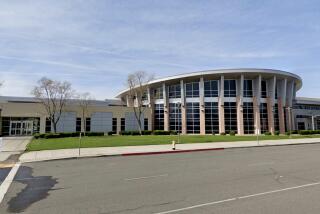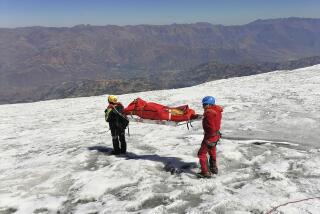Crash Led to an Ordeal High in the Sierra
Lauren Elder will never know why she survived the plane crash that killed two friends and stranded her on an icy Sierra mountaintop, wearing a lightweight skirt and vest and high-heeled boots.
But she knows how she survived below-freezing temperatures when the plane crashed 30 years ago: by climbing down a 13,264-foot snow-covered mountain in spite of a broken arm, shattered teeth and a gashed and swollen leg.
Her fearless determination to survive came from a sense of responsibility to others, especially her mother and grandmother, Elder said in a recent interview.
âThey had lost my uncle in a plane crash; I didnât want them to lose me too. It was part sheer animal will and another part my ego -- my resume was too short.â
Elder, 59, an Oakland artist who teaches college art classes and designs public spaces, said surviving as an artist for 30 years has required âfar more fortitude than those two days.â
Her 14-hour climb down Mt. Bradley -- which lies north of Mt. Whitney, the highest peak in the Lower 48 -- was recounted in her 1978 book âAnd I Alone Survived.â Last month, the Discovery Channel explored her ordeal.
*
April 26, 1976, began with a surprise: Elder and two friends took off on a Monday from Oakland Airport for a half-day outing in Death Valley. Elder, then 29, hadnât been scheduled to go. But her boyfriend, Jim Fizdale, âbacked out at the last minute because he had a work shift,â she said. âI took his place in the plane.â
She dashed out the door without panties. âI was in a rush and had no clean underwear that day ... just what mothers warn you not to do,â she said in the recent Times interview.
Oakland veterinarian Jay M. Fuller, who worked with Fizdale, was piloting the single-engine red and white Cessna 182. The other passenger was Fullerâs girlfriend, Jean Noller.
The day was clear and calm, Elder recalled in her book. After she became accustomed to the planeâs plunges, she wrote, âI felt a kind of thrill at our daring. Jay was having a wonderful time, slipping the little plane through these valleys and massive mountains, acting like guide to two thoroughly engrossed women.â
Elder, seated in back, unsnapped her seat belt to get the best angle to shoot photographs of the Sierra. Suddenly, the plane hit a downdraft and nosed into the mountainside, 15 feet below the summit.
The plane broke nearly in half. Elder crawled out of the tail. Fuller was already out, despite a head gash and internal injuries. They pulled out his unconscious girlfriend, who had a severe head injury and a slashed face.
Then Fuller sat down, confused and disoriented, Elder wrote. She emptied some beer bottles and collected gasoline that was dripping from the planeâs leaking tank. With no wood to burn on the barren mountaintop, she tossed the gas on the rocks and lighted it.
As Noller lay on the ground, âshe was very strong and unruly ... sort of moaning and whining, just anguished sounds,â Elder told The Times in 1976.
At some point, as Fuller worked the radio and Elder caught the dripping gas, Noller began convulsing and slipped down the mountain slope. âWe couldnât find her,â Elder said.
The stunned survivors sat near the flaming rocks. Fuller told Elder that he had activated the emergency beacon in the tail of the plane, then he slumped into lethargy. Elder yelled at him to help her, but he only kept reproaching himself.
âI did a dumb thing, really dumb,â Fuller said, according to Elderâs book. âI should have circled. Should have made another approach to gain altitude. There were downdrafts.â
âWe were both beyond tears,â Elder wrote. âI felt a surge of sorrow for him.â
As the night grew colder, the wind blew out the fire. Elder moved the hot rocks into the tail section of the plane, where she and Fuller curled up.
For hours Fuller lay quietly. Suddenly, he thrashed, pounding his fists and head against the inside of the plane. Finally he stopped, and both slept.
She awoke around dawn. Fuller lay motionless. In the night, he had thrown off his coverings, exposing his body to the elements.
âI sat there a long time, looking at him. His eyes were open and staring,â Elder wrote. âI had not known that was what it was like to die.â She would later learn that he had died of hypothermia and internal injuries.
Meanwhile, back in Oakland, loved ones started to worry when the trio didnât return by 6 p.m. Fullerâs daughter, Carla, 10, was home alone. By 7 p.m., she called Elderâs boyfriend, Fizdale, who drove to Fullerâs house. He began making calls to airfields and search-and-rescue groups.
At 2.24 a.m. Tuesday, April 27 -- as Elder dozed in the plane -- the FAA issued an alert. By dawn, as she awoke to find Fullerâs body, nearly a dozen pilots with the Civil Air Patrol and Air Force Rescue Center were in the air searching.
As the sun rose higher, Elder moved outside to sit on a ridge. She warmed her face and hands in the sunlight and tried to decide whether to wait at the wrecked plane for help or attempt to navigate the grueling route to safety. When a small plane flew overhead and its pilot didnât see her frantic waving, she decided to take a chance on getting out herself.
The eastern edge of the mountain drops at about a 45-degree angle, sometimes steeper. So Elder descended diagonally across the icy, granite face.
Ignoring the cold and the pain, she moved on all fours, âdoing a kind of sideways spider walk,â she said. She used her boots and her fists as ice picks, punching through the crust to make handholds and toeholds.
The effort kept her warm, but once, halfway along an outcropping, âa gust of cold air blew up under my skirt, billowing my wraparound and chilling my bare behind. I yelped, but held on,â Elder wrote.
When the incline lessened, about a third of the way down, she tucked her skirt between her legs and under her rear for protection, then slid down the icy slope.
She was exhilarated; the hardest part was over. By midmorning, she was able to stand up and start sidestepping down the slope, even as knee-deep snow filled her boots.
Meanwhile, sometime after 8 a.m., Fizdale contacted Elderâs father, Robert, a former World War II Navy pilot and director of flight test operations for Northrop Aviation in Los Angeles. Northrop sent a plane to help.
About the same time, other rescue pilots spotted the Cessna but saw no sign of life. Her family began to plan her funeral.
By late afternoon, Elder was drinking from the pool of a waterfall near the bottom of the mountain. She had removed her shredded boots and walked barefoot along a stream bed.
âI was hallucinating along the way.... I thought I saw houses and they turned out to be rocks. I would see people and could climb down to talk to them. They would be a bunch of reeds,â Elder told The Times in 1976.
She reached the town of Independence, her clothes ripped and caked with dried blood. Her feet kept moving toward a glowing motel sign and, soon, into the arms of the Inyo County sheriff.
On April 27, just after 10 p.m. -- more than 34 hours after taking off from Oakland, and after a 10-mile descent and a 10-mile walk -- Elder was admitted to the Lone Pine hospital. She had blistered, mildly frostbitten feet and a fractured arm.
A rescue team found Nollerâs body 120 feet below the Cessna. Fullerâs body was hanging half outside the plane, his hair dusted with snow.
Three months later, Elder returned to the Sierra -- her arm still in a cast, her foot not yet healed. She and a friend hiked below the crash site.
âI had to go back,â she said in the recent Times interview. âI felt like the mountain had some kind of power over me.â
It would be nearly 30 years before she would set foot in another small aircraft, however -- one the Discovery Channel chartered to return her to the scene.
Life has been gentler since the accident, but, Elder says, she misses that rare, focused moment, the âclarity of knowing precisely what I had to do next -- or else die.â
More to Read
Sign up for Essential California
The most important California stories and recommendations in your inbox every morning.
You may occasionally receive promotional content from the Los Angeles Times.










